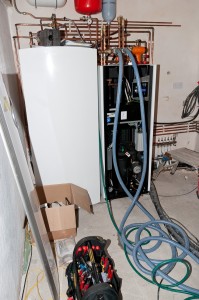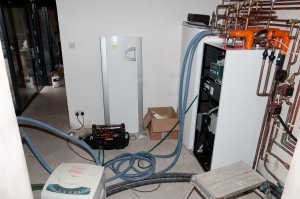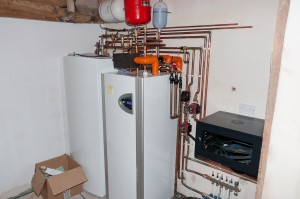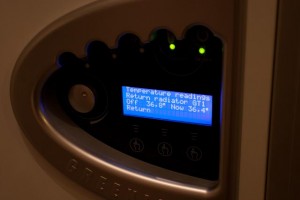After several months of research, product sourcing, price negotiation, grant and subsidy research, extensive groundworks and final installation, I am very pleased to announce that our ground source heat pump has now been commissioned and is up and running providing heating and domestic hot water for the whole house!
Commissioning

The process of commissioning the heat pump is quite lengthy and involves several steps including:
- checking the basic installation
- making final electrical connections to the heat pump
- filling the ground loop with the water/glycol heat transfer fluid
- test running the pump components
- setting initial heat pump controller settings
- heating the contents of the 300 litre hot water cylinder using the in-built immersion heaters to bring it close to working temperature
All of this was carried out by Ben, a very knowledgeable and competent engineer from ICE Energy and after all the steps were completed the heat pump was powered up and it got up to speed in no time at all.
Initial impressions
The first thing I was relieved to notice was that the heat pump is very quiet. As it is situated in the new enlarged hallway next to the new family room I was praying that it wouldn’t be too loud so as to be noticeable. I had previously been told that it would not sound any louder than a typical fridge but I was still slightly apprehensive given it’s position in the house. However I’m happy to say that it is absolutely fine from a noise perspective. Additionally, it will be enclosed in a purpose built cupboard with the potential for further internal soundproofing so noise will not be an issue.
The second thing I noticed was how quickly it got up to speed heating up both the new underfloor heating and existing radiators in next to no time.
One minor worry we’d had in our minds throughout the installation of this system was whether it would provide sufficient heat for the radiators in the existing part of the house (2/3 of the total house split over 2 floors). As the temperature of the water output from the heat pump is lower than that from other hot water boilers typically used with radiators, we’d been told that the radiators would never get as hot as previously, feeling only lukewarm to the touch. However, since the heat pump was switched on the radiators have felt no cooler than before which was quite a surprise!
The control system for the heat pump is very different to controls found on traditional heating systems, with numerous temperature sensors monitoring the outdoor and indoor temperatures, flow and return temperatures for the ground loop heat transfer fluid, radiators and underfloor heating and using these in combination with various heat curve settings in order to determine how much heat is required from the pump. The wealth of control settings is quite overwhelming but apparently once the system is established we should hardly, if ever, need to adjust these settings.


In conclusion
Overall, I’d say the house has been hotter than we expected since the heat pump took over from the old system, which is reassuring given our initial concerns about how it would cope with so many radiators.
Although the heat pump was configured with an initial range of settings I’m sure there will be lots of tweaking (in consultation with ICE Energy’s excellent technical support line) over the next few weeks until we get to a point where we are comfortable with everything.



